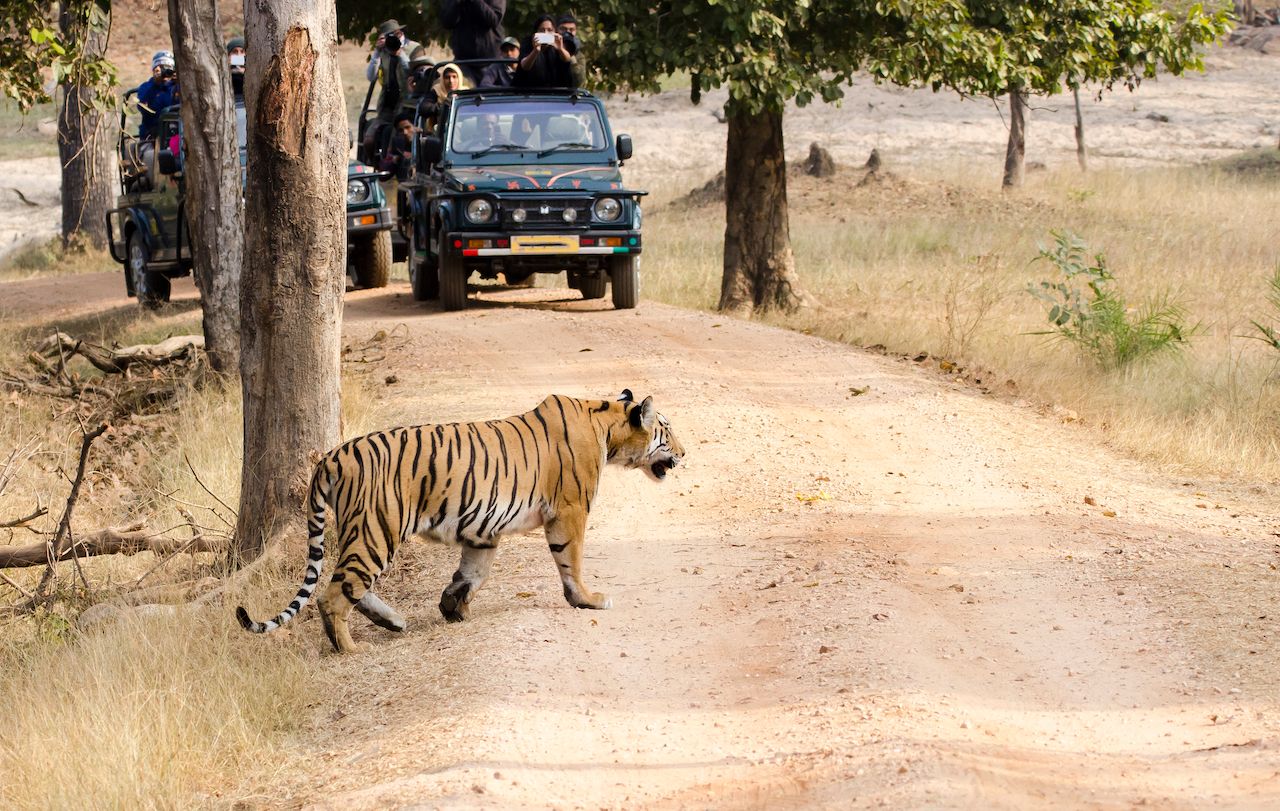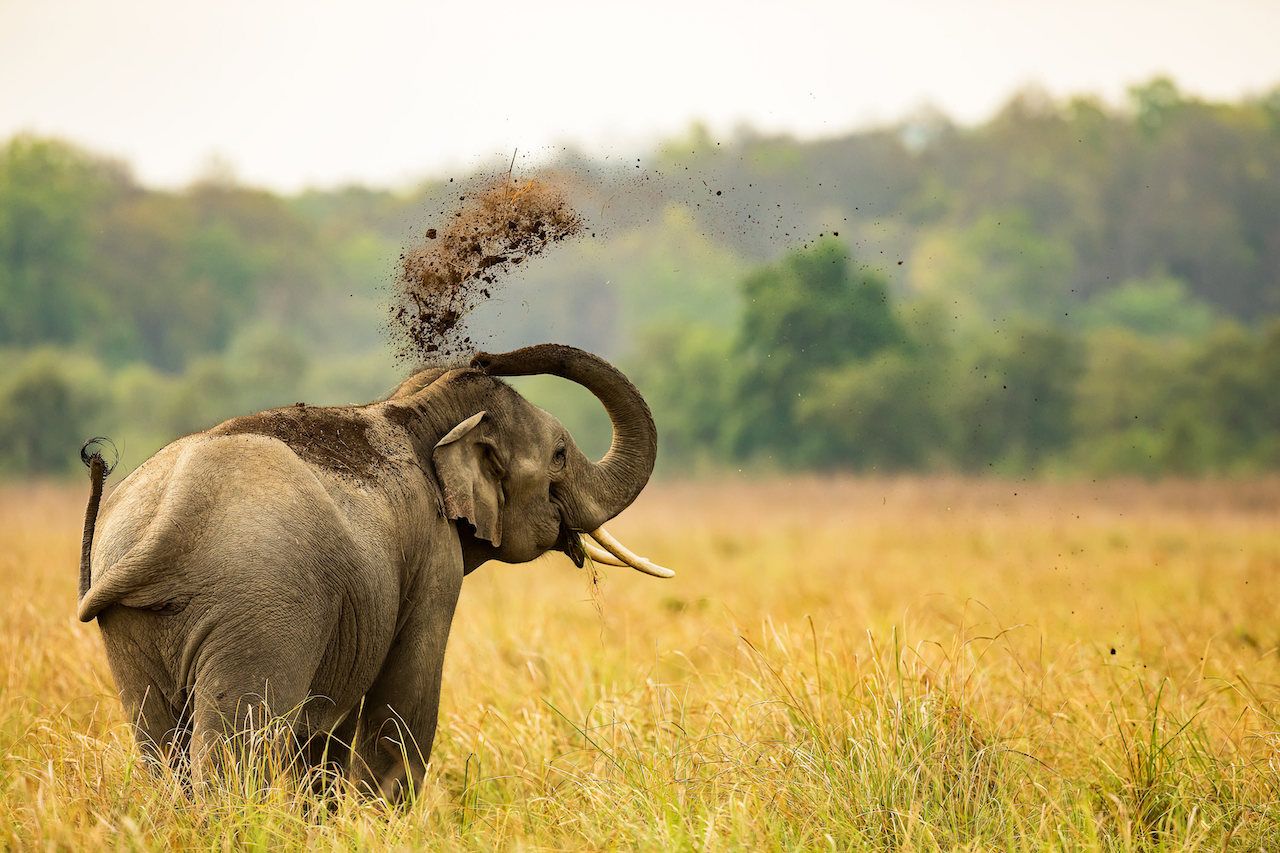While you’ve probably seen captive tigers at zoos around the world, seeing one roaming wild is perhaps the most amazing wildlife experience you could ever have. The best place to view tigers in the wild is India, which is home to two-thirds of the world’s tiger population. India is home to the Royal Bengal tiger, the most numerous of the world’s six surviving subspecies. Bengal tigers are also found in the neighboring countries of Bangladesh, Nepal, and Bhutan.

India Is the Best Place to See Tigers in the Wild, Thanks to Conservation Efforts
A history of tigers in India: from the pride of the nation to the brink of extinction

Photo: Rudra Narayan Mitra/Shutterstock
Tigers have a special place in India’s history and heritage. Some of the earliest representations of today’s endangered national animal can be found in the rock art of Central India dating as far back as 10,000 years, followed by on the seals of the Indus Valley Civilization. The tiger has also served as the royal emblem of the Chola Empire (one of the longest-ruling dynasties in the world), been sculpted in Emperor of Mysore Tipu Sultan’s throne, and appeared on the currency notes of India.
There are references to the power and magnificence of tigers in Vedic literature and Hindu mythology. They’re believed to be the divine vehicle (vahana) of the Hindu goddess Durga. Tribal inhabitants of the nation have also venerated this incredible beast for their religious and cultural purposes. Warli, the indigenous tribe of Maharashtra, worship the tiger as god Vaghadeva. According to them, the tiger symbolizes life and regeneration.
In the Sanguem and Sattari districts of Goa, forest-dwelling communities revere tigers as powerful protectors while the Naga tribe of Northeast India believes that tiger and man are brothers, one striped, the other human. Meanwhile, in Central India, the Baigas ethnic group considers itself a descendant of the tiger, and the Soligas, an indigenous tribe of Karnataka, live in a forest alongside tigers and worship them as Huliverappa, or the Tiger god.
Sadly, despite their status and heritage, many factors have led to a huge decline in the numbers of tigers in India, and poaching is a significant one. Since the 16th century, tigers have been hunted across India. For Mughals, hunting a tiger was a sign of power and royalty, while for the British it was a favored pastime that quickly became a prestigious sport. Tigers were prized as trophies and hunted for body parts that were used in traditional medicinal products, clothing, and elsewhere.
After India’s independence in 1947, tiger poaching escalated. Meanwhile, an inadequate protection infrastructure, lack of genetic diversity, animal-on-human conflict, and loss of natural habitat due to agricultural and developmental activities further diminished the population of these endangered animals.
Conservation projects are making a difference

Photo: Anuradha Marwah/Shutterstock
In response to hunters decimating the country’s tigers, the Indian government imposed a national ban on tiger hunting in 1970, and in 1972, the Wildlife Protection Act came into force. Hunting or poaching and trade of skin and body parts of wild animals, including Indian tigers, became a punishable offence under the act.
Over the years, tiger-friendly amendments have been added to the act. In 1973, a tiger conservation program called “Project Tiger” was launched by India’s government. Aimed at saving the Royal Bengal tigers from extinction, this was perhaps one of the largest tiger conservation initiatives in the world. Today, around 50 national parks and tiger reserves in India are involved in this project, which has had mixed results.
While poaching remains a continual threat, the protection and conservation efforts by the Government of India and organizations such as WWF (World Wildlife Fund) have shown an improvement in the tiger population. According to a census taken in 2018, there are 2,967 tigers in India. The number represents a 33 percent increase in the tiger population since 2014.
India’s hotspots for tiger-spotting
The best place for tiger-spotting in India is the central Indian state of Madhya Pradesh. It has six tiger reserves — the most of any state in India — and the highest number of tigers. It had 526 tigers at the last count and has earned its reputation as the “Tiger State” of India.
1. Bandhavgarh National Park — Madhya Pradesh

Photo: Travel Stock/Shutterstock
Of all the national parks in India, Bandhavgarh National Park is where you are most likely to spot a tiger up close. There are currently around 60 Royal Bengal tigers, plus a healthy population of sloth bear, leopard, sambar, and a wide array of exotic birds. The park also has ancient ruins of forts, hand-carved hermit caves, and statues.
The park has three core sections: Tala, Khitauli, and Magadhi. These are flanked by three buffer zones — Dhamokhar, Johila, and Panpatha — thus providing more space for the park’s ever-expanding number of tigers. Guests can do a guided tour in a four-wheel drive vehicle, a Maruti Gypsy jeep, which is available in all the zones. You could also opt for a larger canter safari on an open-air minibus that is conducted only in the Magadhi and Khitauli zones.
The park is not easy to get to, and you’ll need to buy a safari permit to visit, but you’ll be glad you made the effort. Safari excursions run twice daily — morning and afternoon — and you can book the permit online through the MP Forest Department website. The vehicle and guide fees are to be paid separately at the park before taking the safari. For the best chance of tiger sightings, visit between March and May when the temperature increases, and the big cats come out to cool themselves near the watering holes.
Where to stay: There are several lodges and resorts within the park, mainly in the Tala zone. Many of them provide private safaris along with a guide and vehicle. The Tree House Hideaway and the MP Tourism’s White Tiger Forest Lodge are some great options.
2. Kanha Tiger Reserve — Madhya Pradesh

Photo: Anuradha Marwah/Shutterstock
Covering over 360 square miles, Kanha Tiger Reserve — also called Kanha National Park — is perhaps most recognizable as the setting for Rudyard Kipling’s classic novel The Jungle Book. Its landscape is a mixture of deciduous forests and grasslands that harbor most of The Jungle Book’s wildlife, including Bengal tigers, leopards, sloth bears, Indian wolves, and jackal.
The endangered hard-ground swamp deer (barasingha) can also be found here, as can a variety of other animals, 300 species of birds, and more than 1,000 species of flowering plants. To see the wildlife, especially big cats, try visiting in March or April when the animals gather around the watering holes of Babathenga Tank and Sondar Tank. Safari by jeep is available and can be booked online.
Where to stay: There are many places to reside within the park, from basic rest houses to luxury lodges. Kanha Village Eco Resort is an award-winning local sustainable tourism initiative.
3. Pench Tiger Reserve — Madhya Pradesh

Photo: Chaithanya Krishnan/Shutterstock
Straddling the border between Madhya Pradesh and Maharashtra, Pench Tiger Reserve — or Pench National Park — is also said to have inspired Kipling’s The Jungle Book. Here is where you can see hundreds of species of birds, Indian leopards, gaur, Indian wolf, four-horned antelope, and several other animals, but the main attraction is the Bengal tigers, of which there are over 40.
Safari by jeep and elephant-back — although we don’t encourage riding elephants — will take you deeper into the tropical deciduous forest, where tiger sightings are most common at the height of the dry season in April and May. Outside of wildlife, visitors can also take advantage of other activities, including boating, camping, and visiting the potter’s village situated near the Turia gate of the park.
Where to stay: Stay right in the heart of the reserve at Pench Jungle Camp.
4. Sundarbans National Park — West Bengal

Photo: Santhosh Varghese/Shutterstock
A complex ecosystem combining massive mangrove forests and deltaic floodplains, the Sundarbans National Park — stretching from India to Bangladesh — can only be accessed by boat. While there are multiple points of entry to this UNESCO World Heritage site, most boat tours begin from Godkhali Port, situated by Gosaba, which is the last inhabited island before the forest deepens. The park contains many endangered animal species, especially Royal Bengal tigers, along with a large number of reptiles, avifauna, and marine mammals including Irrawaddy dolphins.
As per the last count, the number of tigers in the park is about 88 on the Indian side; efforts are currently underway to get a more up-to-date count. Tiger sightings aren’t guaranteed here due to the swampy nature of the park. However, your best chance to spot them is in winter (November-February) from the Sudhanyakhali Watch Tower situated deep within the forest. Alternatively, you can take a river safari to see the swimming tigers.
Where to stay: Book a room at eco-friendly Sunderban Jungle Camp to support the locals, or at Sunderban Tiger Camp, which reflects the local culture and flavor of the region.
5. Jim Corbett National Park, Uttarakhand

Photo: Ketan Vikamsey/Shutterstock
Located in the foothills of the Himalayas, the Corbett National Park is named after the world’s first tiger conservationist, Jim Corbett. It is the busiest and oldest national park in the country, and also the first place where “Project Tiger” was launched. Featuring an extensive stretch of grasslands, as well as riverine belts and a mix of sal and deciduous forests, the parks sustain an abundance of flora and fauna, including 215 tigers. Due to thick foliage, tiger encounters are a hit-and-miss, but the park is one of the major ecotourism destinations in India.
Look out for leopard, Asian elephant, gharial crocodile, spotted deer and wild boars. Ardent birdwatchers must definitely visit the park as it is home to over 580 species of resident and migratory birds. The park can be explored by jeep safari that is conducted twice a day: early morning and late afternoon. Dhikala and Bijrani are the popular zones for a wildlife safari.
Where to stay: There is a wide range of rest houses in the park’s six zones. Book a place in Dhikala Forest Lodge in Dhikala zone, which is perhaps an easy getaway to the various parts of the park.
6. Ranthambore National Park, Rajasthan

Photo: Santhosh Varghese/Shutterstock
Once home to the hunting grounds of the princes of Jaipur, Ranthambore National Park, situated in Sawai Madhopur district of Rajasthan, is today a stomping ground for a healthy population of tigers. Currently, there are 71 tigers in the park, and with continued tiger conservation efforts, chances are high that the population will continue to thrive.
The park is divided into ten zones, of which by far the best for sighting the jungle cat are zones one and six, in the months of October to April. The best way to view them is on a gypsy or canter truck safari. But it’s not only tigers you’ll see here; leopards, marsh crocodiles, hyenas, elusive Indian wolf, and over 250 species of birds also call the park home. Plus, you will also see living temples and royal ruins while on the guided safari.
Where to stay: Located less than a 10-minute drive from the entrance of the park, Sher Bagh is a luxurious jungle lodge reminiscent of the 1920s safari encampments.
7. Tadoba-Andhari Tiger Reserve, Maharashtra

Photo: Amitrane/Shutterstock
The largest and oldest national park in Maharashtra, Tadoba-Andhari Tiger Reserve is not as well-known as other parks in India. And that’s the beauty of it. The park has a lot to offer, which can be enjoyed sans the tourist crowds. The landscape is stunning; the dry deciduous forests contrast with the deep valleys and smooth meadows. The best part, however, is that the reserve has a high density of tigers (around 88) and sightings are almost guaranteed. Buses and open-top jeep safaris are available along with a trained local guide. There’s also a good chance of seeing leopards, sloths, nilgai, and over 200 species of birds. The reserve remains open throughout the year, unlike many in India. The hotter months (March, April, and May) are best for tiger-spotting.
Where to stay: For an unbeatable wildlife experience, head to Tiger Trails Jungle Lodge that is located within the conservation area on the park’s borders.
8. Bandipur Tiger Reserve and National Park, Karnataka

Photo: Raj Wildberry/Shutterstock
Once the private game reserve of the Kings of Mysore, the Bandipur National Park — part of the Nilgiri Biosphere Reserve — is now a protected zone for tigers and several other animal species. The chances of spotting the elusive tiger on safari here are good, with its small streams and the banks of the River Kabini making ideal stakeout points. Jeep Safari operated by Bandipur Safari Lodge and Tusker Trails Resort, and canter (minibus) safari are available. For the most reliable wildlife sightings, visit between October and May.
Where to stay: The eco-friendly homestay Dhole’s Den and Bandipur Safari Lodge are popular choices.
NOTE: Many of the national parks in India remain closed during monsoon (July — September); while those that remain open, safaris may not operate and wildlife sighting is a challenge.